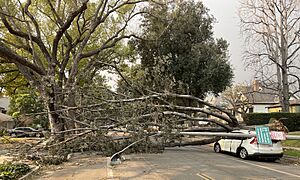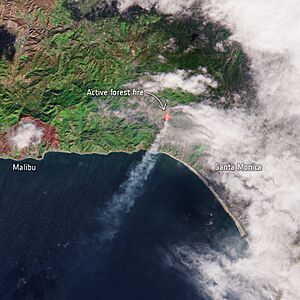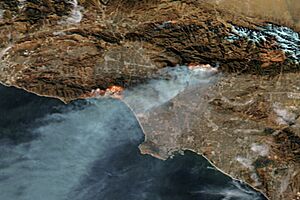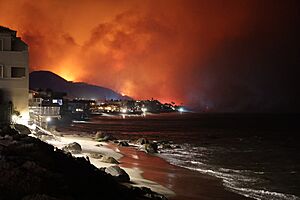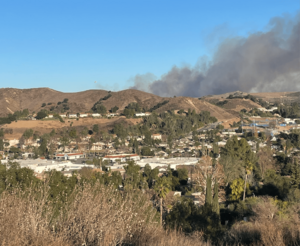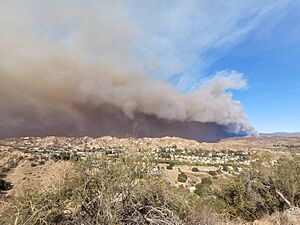January 2025 Southern California wildfires facts for kids
Quick facts for kids January 2025 Southern California wildfires |
|
|---|---|
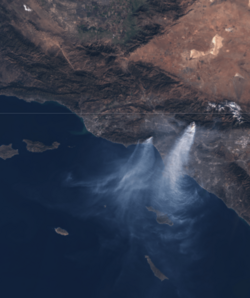
Sentinel-3 satellite image of the Palisades (left) and Eaton (right) fires burning near Los Angeles, California, on January 9, 2025.
|
|
| Location | Los Angeles, Orange, Riverside, San Bernardino, San Diego and Ventura counties, California |
| Statistics | |
| Date(s) | January 7–31, 2025 (24 days) |
| Burned area | Roughly 57,636 acres (23,324 ha; 90 sq mi; 233 km2) |
| Cause | Under investigation, made worse by strong Santa Ana winds and very dry conditions |
| Buildings destroyed | 18,189+ destroyed or damaged |
| Deaths | 31 |
| Missing people | 31+ |
| Evacuated | 200,000+ |
In January 2025, a series of 14 major wildfires burned across Southern California. The fires were especially dangerous because of very dry conditions, low moisture in the air, and powerful Santa Ana winds. Some winds were as strong as a hurricane, reaching speeds of 100 miles per hour (160 km/h).
These fires were a serious disaster. At least 31 people died, and over 200,000 people had to leave their homes. The flames destroyed more than 18,000 buildings and burned over 57,000 acres (23,000 ha; 89 sq mi) of land.
The two biggest fires were the Eaton Fire near Altadena and the Palisades Fire in Pacific Palisades. Firefighters from city departments and the state agency CAL FIRE worked hard to fight the flames. They used special airplanes and teams on the ground. Both fires were finally put out on January 31, 2025. Because of the number of deaths and destroyed homes, these two fires were among the most destructive in California's history.
Contents
What Caused the Fires to Be So Bad?
Weather experts knew that the conditions were perfect for dangerous fires. On January 2, the National Interagency Fire Center (NIFC) warned that Southern California had a high risk for big fires. The local National Weather Service (NWS) also issued a Fire Weather Watch, telling people to be prepared.
The NWS later issued a red flag warning. This is the highest alert for fire danger. They called it a "particularly dangerous situation" because the strong winds and dry air could make fires spread very quickly.
Severe Drought and Climate Change
Southern California was in a severe drought. The months leading up to the fires were the driest ever recorded in the area. This meant that plants, bushes, and trees were extremely dry and could easily catch fire.
Climate change has made the region hotter and has caused big swings in weather. Sometimes there are very heavy rains, which cause a lot of grass and shrubs to grow. Then, long periods of drought dry out all this new growth, turning it into fuel for wildfires. This pattern of wet and dry periods is sometimes called "hydroclimate whiplash."
Scientists have found that climate change makes hot, dry weather more likely to happen at the same time as the Santa Ana winds. This creates the perfect conditions for huge wildfires.
Powerful Santa Ana Winds
The Santa Ana winds during this time were incredibly strong. In some mountain areas, wind gusts were recorded at 100 miles per hour (160 km/h). Even in neighborhoods, winds reached 50 to 80 miles per hour (80 to 129 km/h).
The NWS warned that this could be the "most destructive windstorm seen since 2011." They correctly predicted that the strong winds would knock down trees and cause power outages. These powerful winds helped the fires spread much faster than usual.
Getting Ready for the Fires
On January 6, Gavin Newsom, the Governor of California, prepared firefighting teams. He assigned 65 fire engines, 7 helicopters, and over 100 firefighters to be ready. The Mayor of Los Angeles, Karen Bass, warned residents about the dangerous winds and told them to stay away from fallen power lines.
The main electric company, Southern California Edison, planned to shut off power for some people. This was a safety measure to prevent broken power lines from starting more fires. Some schools in Malibu and other areas were closed to keep students safe.
The Fires Begin
As the strong winds arrived on January 7, the City of Los Angeles declared a state of emergency. The powerful winds knocked down dozens of trees and caused power outages for thousands of people.
The winds were so strong that they also affected air travel. Many flights were delayed or canceled. At Hollywood Burbank Airport, planes had to circle in the air before they could land safely.
List of Major Wildfires
| Name | County | Area | Start date | Containment date | Structures damaged or destroyed | Notes |
|---|---|---|---|---|---|---|
| Palisades | Los Angeles | 23,448 acres (9,489 ha) | January 7 |
|
7,854 | Evacuations; homes destroyed in Pacific Palisades |
| Eaton | Los Angeles | 14,021 acres (5,674 ha) | January 7 |
|
10,491 | Evacuations; structures destroyed in Altadena and Pasadena |
| Hurst | Los Angeles | 799 acres (323 ha) | January 7 |
|
Unknown | Evacuations; homes possibly destroyed in Sylmar |
| Kenneth | Los Angeles/Ventura | 1,052 acres (426 ha) | January 9 |
|
Unknown | Evacuations; began west of West Hills |
| Hughes | Los Angeles/Ventura | 10,425 acres (4,219 ha) | January 22 | January 30 | None | Evacuations; began near Castaic Lake |
| Border 2 | San Diego | 6,625 acres (2,681 ha) | January 23 | January 30 | None | Fire that burned in the Otay Mountain Wilderness |
Major Wildfires
The combination of strong winds and dry plants caused the fires to spread incredibly fast. Wind blew burning pieces of wood, called embers, far away, which started new fires in other places.
Palisades Fire
The Palisades Fire started on January 7 in the Pacific Palisades neighborhood. It grew very quickly. Officials ordered people to evacuate their homes along the Pacific Coast Highway and in parts of Santa Monica and Brentwood.
The fire was so intense that it was growing by "three football fields of land per minute." By the time it was contained on January 31, the fire had burned 23,448 acres and destroyed thousands of homes.
Eaton Fire

The Eaton Fire started on the evening of January 7 in Eaton Canyon, near Altadena and Pasadena. The fire grew from 20 acres to 1,000 acres in just six hours.
Evacuations were ordered for many neighborhoods, including a home for 95 senior citizens. The fire spread into parts of Pasadena, and all of La Cañada Flintridge was told to evacuate. The Eaton Fire was the deadliest of the wildfires, causing 17 deaths. It was fully contained on January 31.
Other Important Fires
- The Hurst Fire started late on January 7 and burned 799 acres near Sylmar. It forced over 44,000 people to evacuate.
- The Kenneth Fire began on January 9 in West Hills and burned 1,052 acres.
- The Hughes Fire started on January 22 near Castaic Lake. It grew to over 10,000 acres and forced 30,000 people to evacuate.
- The Border 2 Fire burned over 6,600 acres in the Otay Mountain Wilderness in San Diego County.
Impact of the Wildfires
The wildfires had a huge effect on the people and communities of Southern California.
Deaths and Injuries
As of July 2025, a total of 31 deaths were caused by the wildfires. The Eaton Fire was responsible for 18 of those deaths, and the Palisades Fire caused 12. Many people were also injured, including a firefighter who suffered a serious head injury.
Damage to Buildings and Homes
The fires destroyed thousands of buildings. The Palisades fire alone destroyed over 1,000 structures, including homes, schools, and businesses. The historic Reel Inn restaurant and the Palisades Charter High School were both destroyed.
Many celebrities lost their homes in the fires, including Jeff Bridges, Tyra Banks, and Julia Louis-Dreyfus. The home and ranch of the famous humorist Will Rogers was also destroyed.
Power Outages and Air Quality

At the peak of the disaster, over 400,000 people were without electricity. The smoke from the fires made the air quality very unhealthy. In some areas, the air was considered "hazardous," and people were told to stay indoors with their windows closed. Health experts warned that the smoke could cause burning eyes and breathing problems, especially for people with asthma.
Water Supply Problems
During the fires, firefighters in some areas ran out of water. The water storage tanks and pumps could not keep up with the huge amount of water needed to fight the flames. The system was not designed to handle a fire that destroyed hundreds of homes at once.
To make matters worse, a large water reservoir in the Pacific Palisades had been emptied for repairs. If it had been full, it might have helped provide more water pressure for firefighters.
Community and Government Response
Many people and organizations came together to help during the crisis.
Government Actions
California Governor Gavin Newsom and President Joe Biden worked to get federal help for firefighting efforts. Newsom also created a website to give people correct information and stop the spread of rumors about the fires.
Los Angeles Mayor Karen Bass returned early from a trip to Ghana to lead the city's response. There was some debate about the city's fire department budget, but officials stated that funding had actually increased and did not affect the response.
Help from Sports and Entertainment
The Los Angeles Rams football team wore hats to support the LA Fire Department during a playoff game. All twelve professional sports teams in the Los Angeles area donated over $8 million to help victims.
Many celebrities, including Taylor Swift, Leonardo DiCaprio, and Beyoncé, donated money to relief organizations. The Weeknd postponed his new album release out of respect for the victims.
See also
 In Spanish: Incendios forestales de California de 2025 para niños
In Spanish: Incendios forestales de California de 2025 para niños
- 2025 United States wildfires
- 2025 California wildfires
- 2003 California wildfires
- October 2007 California wildfires
- December 2017 Southern California wildfires
- Marshall Fire
- Watch Duty






